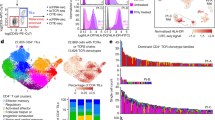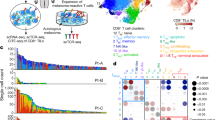Abstract
To characterize the anti-melanoma reactivity of CD8+ cytotoxic T lymphocytes (CTL) from choroidal melanoma patients, CTL clones were isolated from the peripheral blood of three patients after mixed lymphocyte/tumor cell culture (MLTC). Clones were derived from lymphocytes stimulated by allogeneic (OCM-1, A24, A28) or autologous (OCM-3, Al, A30) melanoma cells. Their reactivity against a panel of HLA-typed melanoma and nonmelanoma cells was assessed, to determine whether a single CTL clone could recognize and lyse a variety of allogeneic melanoma cell lines. While proportionately more clones derived from autologous MLTC were melanoma-specific than allogeneic MLTC (42% versus 14%), melanoma-specific CTL were recovered from both. Notably, a novel melanoma specificity was identified. These CTL clones were termed non-fastidious because they were capable of lysing melanoma cells with which they had no HLA class I alleles in common. Nonetheless, lysis was mediated by the HLA class I molecule. Since lysis was specific for melanoma cells, these CTL appeared to recognize a shared melanoma peptide(s). Because of their prevalence, we propose that non-fastidious CTL are integral to human anti-melanoma T cell immunity. This reinforces clinical findings that allogeneic melanomas can substitute for autologous tumors in active specific immunotherapy. By circumventing the need for autologous melanoma, it is possible to treat patients after removal of the primary choroidal melanoma in an attempt to prevent metastasis.
Similar content being viewed by others
References
Hersey P (1992) Examination of the scientific basis for vaccines in treatment of melanoma. Vaccine Res 1: 357
Mitchell MS, Kan-Mitchell J, Kempf RA, Harel W, Shau H, Lind S (1988) Active specific immunotherapy for melanoma: phase 1 trial of allogeneic lysates and a novel adjuvant. Cancer Res 48: 5883
Mitchell MS, Harel W, Kempf RA, Hu E, Kan-Mitchell J, Boswell WB, Dean G, Stevenson L (1990) Active-specific immunotherapy for melanoma. J Clin Oncol 8:856
Mitchell MS (1991) Attempts to optimize active specific immunotherapy for melanoma. Int Rev Immunol 7: 331
Topalian SL, Rosenberg SA (1990) Tumor infiltrating lymphocytes: evidence for specific immune reactions against growing cancers in mice and humans. In: DeVita VT, Hellman SA, Rosenberg SA (eds) Important advances in oncology. Lippincott, Philadelphia, p 19
Vose BM, Vanky F, Klein E (1977) Lymphocyte cytotoxicity against autologous tumor biosy cells in humans. Int J Cancer 20: 512
Mukherji B, Flowers L, Rothman L, Nathanson L (1980) Spontaneous in vitro cytotoxicity against autochthonous human melanoma cells. J Immunol 124: 412
Itoh K, Tilden AB, Balch CM (1986) Interleukin 2 activation of cytotoxic T-lymphocytes infiltrating into human metastatic metanomas. Cancer Res 46: 3011
Parmiani G, Anichini A, Fossati G (1990) Cellular immune response against autologous human malignant melanoma: are in vitro studies providing a framework for a more effective immunotherapy? J Natl Cancer Inst 82: 361
Egan KM, Seddon JM, Glynn RJ, Gragoudas ES, Albert DM, (1988) Epidemiologic aspects of uveal melanoma. Surv Ophthalmol 32: 239
Diener-West M, Hawkins BS, Markowitz JA, Schachat AP (1992) A review of mortality from choroidal melanoma. II. A meta-analysis of 5-year mortality rates following enucleation, 1966 through 1988. Arch Ophthalmol 110: 245
Shields JA, Augsburger JJ, Donoso LA, Bernardino VB Jr (1985) Hepatic metastasis and orbita recurrence of uveal melanoma after 42 years. Am J Ophthalmol 100: 666
Albert DM, Niffenegger AS, Wilson JKV (1992) Treatment of metastatic uveal melanoma: review and recommendations. Surv Ophthalmol 36: 429
Cruz PO de la, Specht CS, McLean IW (1990) Lymphocytic infiltration in uveal malignant melanoma. Cancer 65: 112
Durie FH, Campbell AM, Lee WR, Damato BE (1990) Analysis of lymphocytic infiltration in uveal melanoma. Invest Ophthalmol Vis Sci 31: 2106
Ksander BR, Rubsamen PE, Olsen KR, Cousins SW, Streilein JW (1991) Studies of tumor-infiltration lymphocytes from a human choroidal melanoma. Invest Ophthalmol Vis Sci 32: 3198
Niederkorn JY (1990) Immune privilege and immune regulation in the eye. Adv Immunol 48: 191
Kan-Mitchell J, Mitchell MS, Rao N, Liggett PE (1989) Characterization of uveal melanoma cell lines that grow as xenografts in rabbit eyes. Invest Ophthalmol Vis Sci 30: 829
Kan-Mitchell J, Liggett PE, Harel W, Steinman L, Nitta T, Oksenberg JR, Posner MR, Mitchell MS (1991) Lymphocytes cytotoxic to uveal and skin melanoma cells from peripheral blood of ocular melanoma patients. Cancer Immunol Immunother 33: 333
Uchida A (1993) Biological significance of autologous tumourkilling activity and its induction therapy. Cancer Immunol Immunother 37: 75
Knapp W, Rieber P, Dorken B, Schmidt RE, Stein H, Borne AEGKrvd (1989) Towards a better definition of human leucocyte surface molecules. Immunol Today 10: 253
Zinkernagel RM, Doherty PC (1979) MHC-restricted cytotoxic T cells: studies on the biological role of polymorphic major transplantation antigens determining T cells restriction-specificity, function and responsiveness. Adv Immunol 27: 51
Mukherji B, Chakraborty NG, Sivanandham M (1990) T cell clones that react against autologous human tumors. Immunol Rev 116: 33
Darrow TL, Slingluff CL, Seigler HF (1989) The role of HLA class I antigens in recognition of melanoma cells by tumor-specific cytotoxic T lymphocytes. J Immunol 142: 3329
Woelfel T, Klehmann E, Muller C, Schutt K, Zum Bushenfelde KHM, Knuth A (1989) Lysis of human melanoma cells by autologous cytolytic T cell clones. Identification of human histocompatibility leukocyte antigen A2 as a restriction element for three different antigens. J Exp Med 170: 797
Crowley NJ, Darrow TL, Quinn-Allen MA, Seigler HF (1991) MHC-restricted recognition of autologous melanoma by tumor-specific cytotoxic T cells. Evidence for restriction by a dominant HLA-A allele. J Immunol 146: 1692
Kan-Mitchell J, Huang X-Q, Steinman L, Oksenberg JR, Harel W, Parker JW, Goedegebuure PS, Darrow TL, Mitchell MS (1993) Clonal analysis of in vivo-activated CD8+ cytotoxic T lymphocytes from a melanoma patient responsive to active specific immunotherapy. Cancer Immunol Immunother 37: 15
Schwartz BD (1991) The human major histocompatibility human leukocyte antigen (HLA) complex. In: Stites DP, Terr AI (eds) Basic and clinical immunology, 7th edn. Appleton & Lange, Norwalk, Conn, p 45
Lopez de Castro JA, Strominger JL, Strong DM, Orr HT (1982) Structure of crossreactive human histocompatibility antigens HLA-A28 and HLA-A2: possible implications for the generation of HLA polymorphism. Proc Natl Acad Sci USA 79: 3813
Pandovan E, Casorati G, Dellabona P, Meyer S, Brockhaus M, Lanzavecchia A (1993) Expression of two T cell receptor α chains: dual receptor T cells. Science 262: 422
Bjorkman PJ, Saper MA, Samraoui B, Bennett WS, Strominger JL, Wiley DC (1987) Structure of the human class I histocompatibility antigen, HLA-A2. Nature 329: 506
Chien Y-H, Davis MM (1993) How αβ T-cell receptors “see” peptide/MHC complexes. Immunol Today 14: 597
Evavold BD, Sloan-Lancaster J, Allen PM (1993) Tickling the TCR: selective T-cell functions stimulated by altered peptide ligands. Immunol Today 14: 602
Anichini A, Mortarini R, Alberti S, Mantovani A, Parmiani G (1993) T-cell-receptor engagement and tumor ICAM-I up-regulation are required to by-pass low susceptibility of melanoma cells to autologous CTL-mediated lysis. Int J Cancer 53: 994
Becker JC, Terineer C, Schmidt RE, Brocker E-B (1993) Soluble intercellular adhesion molecule-1 inhibits MHC-restricted specific T cell/tumor interaction. J Immunol 151: 7224
Goedegebuure PS, Harel W, LeMay L, Kan-Mitchell J, Mitchell MS (1993) Cytotoxic CD4+ lymphocytes clones reactive with melanoma: The role of HLA and accessory molecules. Vaccine Res 2: 249
Davis MM, Chien Y-H (1993) Topology and affinity of T-cell receptor mediated recognition of peptide-MHC complexes. Curr Opin Immunol 5: 45
Sherman LA, Chattopadhyay S (1993) The molecular basis of allorecognition. Annu Rev Immunol 11: 385
Parmiani G (1993) Tumor immunity as autoimmunity, tumor antigens include normal self proteins which stimulate anergic peripheral T cells. Immunol Today 14: 536
Mueller BM, Reisfeld RA (1991) Potential of the scid mouse as a host for human tumors. Cancer Metastasis Rev 10: 193
Author information
Authors and Affiliations
Additional information
Supported by USPHS grants EY-09031 and EY-09427, and the Lucy Adams Choroidal Melanoma Research Fund to J. K.-M.
Rights and permissions
About this article
Cite this article
Huang, X.Q., Mitchell, M.S., Liggett, P.E. et al. Non-fastidious, melanoma-specific CD8+ cytotoxic T lymphocytes from choroidal melanoma patients. Cancer Immunol Immunother 38, 399–405 (1994). https://doi.org/10.1007/BF01517210
Received:
Accepted:
Issue Date:
DOI: https://doi.org/10.1007/BF01517210




